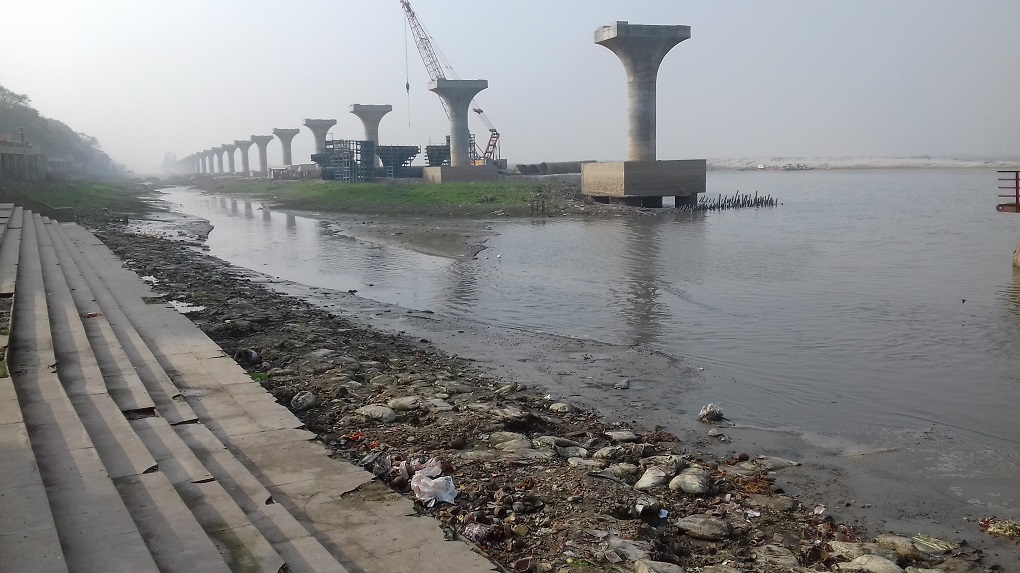The Ganga, which is already in bad shape due to increasing pollution and decreasing water, is now also swiftly moving away from its banks in Patna, the capital of the Indian state of Bihar. No scientific attempt has been made to deal with the crisis, warn experts and activists. Whereas, at the same time, the ambitious Ganga Pathway project, to build 20.5-km elevated road to ease traffic, is underway, and poses a new threat.
Ramakar Jha, of National Institute of Technology, warns Ganga has shifted 2.5–3.5 km from most ghats (steps leading to the river) in Patna in the recent years due to manmade interferences. The construction of Ganga Pathway will push it further. In some places, river Ganga has shifted after work started but by the time it’s finished, river Ganga would have moved away from Patna. He pointed out dangers of construction in the river. As Ganga experiences flooding from Patna to Farakka, silt would be deposited at pillars constructed to support the road. Consequences are hard to foresee but unlikely to be good.
This at a time when beautification is being carried out on 20 ghats in Patna as part of USD 1.5 billion National Ganga River Basin Project, which is supported by World Bank. “What’s the use when Ganga has already shifted from Patna? It’s impossible for visitors to see the river from most ghats,” says Ranjeev, an activist.
“Ghats welcome visitors with dry sand and no sound of the flowing river,” he adds. “Deposit of siltation, depletion of water flow, and encroachment by builder lobby from Digha to Rajapur have diverted this river flow.”
Bihar Urban Infrastructure Development Corporation (BUIDCO) Managing Director Amrendra Prasad Singh says beautification of 16 of 20 ghats has been completed. “Top officials of state administration are serious to bring back this river to the ghats.” Chief Minister of Bihar Nitish Kumar laid the foundation stone for the project in February 2014. It was slated to be complete by June 2016 but it is delayed. Kedar Nath Jha, 92-year-old priest at Collectorate ghat, is a worried witness to shifting away of Ganga. He has lived here for past 49 years, blames interventions in name of development.
“Now filth, silt, and dry sand of the Ganga is found,” he says. It’s a bad sign for Ganga (Mother Ganga), he says. “It’ll be difficult for young generation to accept river water used to flow near Collectorate ghat till 4–5 years ago and, devotees used to take a dip and offering Ganga water at temple,” Jha adds.
He recalls Collectorate ghat’s temple was most crowded, as hundreds used to visit and have glimpse of river till a decade ago. Everything is gone now. River shifted 3.5 kms from the Collecotarate ghat, hardly any devotee visits,” rues Jha and expresses helplessness and pain for not being able to do objection to chief minister Nitish Kumar’s Ganga Pathway project. He said the river has shifted from Collectorate ghat since work started for Ganga-Pathway.
Priest of Adalat ghat temple Baba Mahant Manohar Das says Ganga has shifted away from the ghat and ended the charm of temple. At present, dozens of boats, mostly motor boats operate 2.5–3.5 km away from the banks to ferry villagers of riverine villages for the past few years. Only in the monsoon when water filled dry patches, these motorboats operated from near the ghats. Three years ago, Bihar government’s water resources department and Inland Waterways Authority of India initiated steps to bring the river’s stream back to original course by creating a 7-km long and 15-feet deep channel from Digha to Kalighat. This was due to a directive by Patna High Court in response to a Public Interest Litigation (PIL) filed against the project. But efforts to bring the Ganga close to southern banks despite the Rs. 80 million (USD 1.2 million) spent to create the channel, have failed.
According to a study by researchers from Department of Environment, A N College, Patna, the river Ganga is shifting 0.14 km away every year in Patna. The study blames lack of dredging of riverbed for the past 30 years, and large scale discharge of untreated sewage in the river. In days when steamers navigated the river in state capital, dredgers from Denmark used to dredge riverbed before every rainy season.
According to officials, deep dredging of trench could not be done in the channel after the IWAI refused to carry it due to heavy discharge of untreated waste, including solid waste. Regular disposal of sludge carrying drain water has made it hard to restore the original course of river Ganga. The construction of Ganga Pathway also proved a stumbling block to dredge the channel to ensure the flow of water.
Mohd Imran Khan is a freelance journalist based in Patna
- Pakistan Water Crisis: Water Shortage is a Myth, Says Environment Expert - December 9, 2018
- Rohingya Muslim Refugees Face Monsoons and Disease: Will They Make It? - July 23, 2018
- Mismanaged response to Assam floods: Natural Disaster in India - June 28, 2018
- How River Ganga Is Leaving the Ghats of Patna - June 1, 2018
- Rescuing pygmy hog from brink of extinction: Wildlife Conservation - May 1, 2018
- Hydropower in the Himalayas: economics which are often ignored - April 4, 2018

